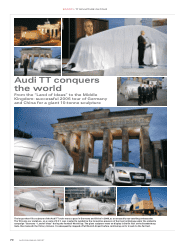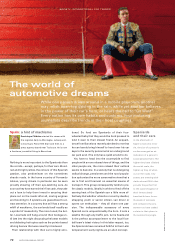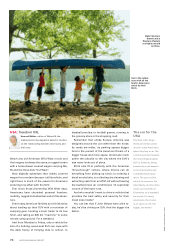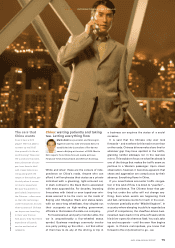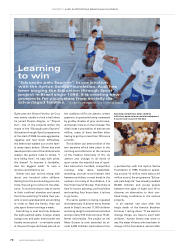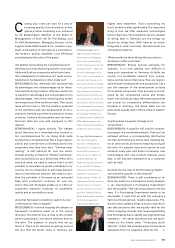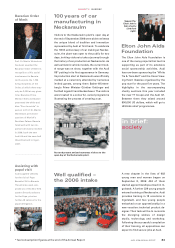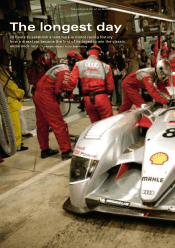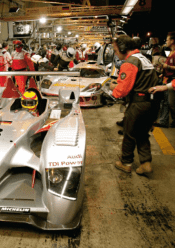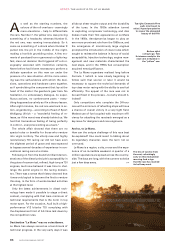Audi 2006 Annual Report Download - page 82
Download and view the complete annual report
Please find page 82 of the 2006 Audi annual report below. You can navigate through the pages in the report by either clicking on the pages listed below, or by using the keyword search tool below to find specific information within the annual report.“Our cus-
tomers
expect zero
faults from
us – and
quite rightly
so. It is
therefore
only logical
for us to
demand the
same zero-
fault quality
from our
suppliers.”
Ulf Berkenhagen
Hella KGaA Hueck & Co.
The automotive supplier
from Lippstadt develops
and manufactures com-
ponents and systems for
lighting technology and
electronics. In addition,
it produces complete
vehicle modules, air con-
ditioning systems and on-
board networks via joint-
venture companies. Hella
has one of the world's
biggest trading organisa-
tions for automotive parts
and accessories. The
group posted revenue of
EUR 3.4 billion in the
2005/2006 financial year.
Hella is among the top 50
automotive suppliers in
the world, and one of
Germany's top 100 indus-
trial companies. It em-
ploys over 24,000 people
worldwide at 70 produc-
tion plants, production
subsidiaries and joint
ventures. Hella's cus-
tomers include all leading
car and systems manu-
facturers, as well as the
automotive parts trade.
SOCIETY: NETWORKED WORKING
80 AUDI 2006 ANNUAL REPORT
parts, components and systems that we buy in
have to be of the right calibre for premium-brand
vehicles in every respect.
What does that mean specifically?
BERKENHAGEN: It specifically means that we are
constantly doing a precarious balancing act. Be-
cause we cannot afford to take decisions solely
on commercial grounds; we also have to ensure
that all other criteria, such as our company’s
quality expectations, are met. We ultimately
can’t afford to enter into a debate with our
customers on whether one or two faults on a car
are still permissible. Our customers expect
zero faults from us – and quite rightly so. It is
therefore only logical for us to demand the same
zero-fault quality from our suppliers. We will
consequently have to operate as a network
to a much greater extent in future than has
previously been the case – both within our own
divisions and of course with our suppliers. We
want to integrate our suppliers even more
deeply into the product development process,
as a way of engendering the mutual trust that
will enable us to create vehicles for which there
is a market.
That sounds like a challenge, Dr. Breidenbach …
BREIDENBACH: Yes, but a challenge that we’ll
willingly rise to.
It sounds like you’re all yearning to live in
harmony and partnership. But the relationship
between manufacturer and supplier has not
always been easy and without its tensions. How
do you propose to flesh out the abstract idea of
“partnership”?
BERKENHAGEN: Well, to use a mathematical
analogy, let’s say that for Dr. Breidenbach two
and two makes five, and for me it makes three.
That’s the philosophical difference between our
professions. Looking at things as partners, on
the other hand, the challenge is to achieve
economical results with a sense of proportion.
Particularly when we are talking about such a
complex product as a headlight.
How exactly does that work?
BERKENHAGEN: To a great extent we agree early
on in the process on how we determine produc-
tivities. This ensures that the supplier, too, is
constantly working on its processes. Only if it
does so will we be able to meet the entrepre-
neurial requirements successfully and optimise
real costs.
That doesn’t exactly sound like partnership …
BERKENHAGEN: But it is! This pressure helps the
supplier as well as us. As Dr. Breidenbach said
earlier, nothing is worse than treading water. Of
course we’ll get into the odd argument about
whether a price is appropriate, amid the fre-
quently misunderstood and much debated issue
of global sourcing. That’s part of the business.
But when you consider what standard of quality
we are now achieving with it, you realise that fair-
n
ess and tough bargaining actually go together.
Any objections, Dr. Breidenbach?
BREIDENBACH: No, not at all. The important
thing forme is that if you assume each party sees
matters from a different viewpoint, you have to
lay down clear rules of the game that both sides
then have to adhere to. By abiding by the rules of
the game, we can then treat each other fairly but
also harshly if necessary. A lengthy partnership
will only come about if both parties get along
well in the prevailing circumstances. I as a sup-
plier can for instance insist on protecting my ex-
pertise. In return, I keep to the cost reductions
agreed with Mr. Berkenhagen.
Mr. Berkenhagen, how do the Purchasing
Department at Audi and the supplier ensure that
both costs and quality meet the customer’s
expectations?
BERKENHAGEN: My general experience is that if
you have suppliers that are having to tackle
problems of cost, there are often also quality
problems somewhere along the line. On the
other hand, if you have a partner in the supply
industry that has got its costs under control, the
quality of its products often also rises.
Wait a minute, many people regard the drive to
cut costs at the supplier as undermining quality.
Now you’re saying precisely the opposite is the
case.
BERKENHAGEN: That’s how it is. If a supplier im-
plements stable, reproducible processes, it also
means for example that they produce less
waste. Less waste in turn means lower costs for
the supplier and higher quality for us. That’s
grossly over-simplified, but basically what it
boils down to.
BREIDENBACH: I couldn’t agree more with what
Mr. Berkenhagen has just said. There’s absolute-
ly no contradiction between low costs and top
quality. Even if it’s often argued that there is. The
attributes of a low-cost, simple solution for a
component, for instance, will almost always


